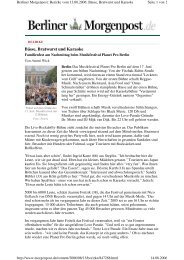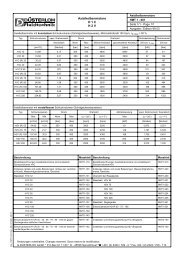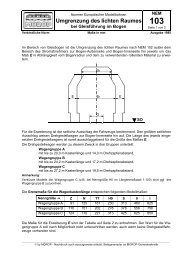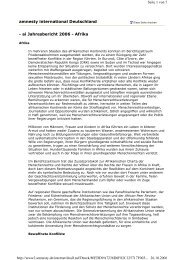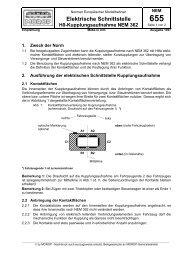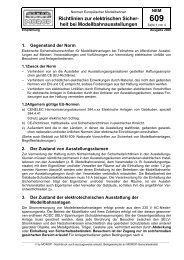1 / Übersicht / Prof. Dr. P. Haas / FH Dortmund / Nov. 2000/ Seite 1 ...
1 / Übersicht / Prof. Dr. P. Haas / FH Dortmund / Nov. 2000/ Seite 1 ...
1 / Übersicht / Prof. Dr. P. Haas / FH Dortmund / Nov. 2000/ Seite 1 ...
Sie wollen auch ein ePaper? Erhöhen Sie die Reichweite Ihrer Titel.
YUMPU macht aus Druck-PDFs automatisch weboptimierte ePaper, die Google liebt.
LV Medizinische Informationssysteme <strong>Prof</strong>.<strong>Dr</strong>.<strong>Haas</strong><br />
recognition (ICR) which scan text line by line, and allow the operator to change or delete text, are not<br />
acceptable under these Level 2 guidelines due to the user's ability to modify the information. The<br />
requirements of Electronic Medical Records described in Level 3 would apply to these imaging methods.<br />
Stufe 3: The Electronic Medical Record (page1)<br />
Stufen nach Med. Records Institut<br />
The electronic medical record is the upgraded version of the computerized medical record. Remember, the<br />
computerized medical record is achieved by using traditional medical records documents and images and<br />
transferring them into computer format. Complete documents with their legal attributes such as date and<br />
signature are converted as a whole from the paper medium to computer. The computerized medical record<br />
can be characterized as having essentially the same structure as the paper-based medical record. The<br />
electronic medical record, on the other hand, has the same scope of information but the information is<br />
rearranged for computer use. This means that it is still governed by the enterprise, may it be a hospital, a<br />
clinic, or other provider, an integrated delivery system, or a network. The enterprise has control over (1) how<br />
the patient is identified, (2) what information is recorded and how (terminology and structure), (3) retention<br />
period (similar or extended from the retention period of paper-based medical records), (4) security (including<br />
access control, electronic signatures, data integrity, and availability), and (5) functionality (determination of<br />
which functions the enterprise would like to have included). Within this context, an enterprise has to design a<br />
system that requires each care giver to use the computer for the accessing and for the recording of<br />
information. The goal of the electronic medical record is to make the various systems within the enterprise<br />
interoperable. Several criteria make up the electronic medical record.<br />
The first and difficult part is to create the enterprise’s infrastructure for appropriate capture, process and<br />
storage of information. For appropriate capturing, users need to be identified and given authorization<br />
according to their status. For instance, when a prescription is issued, the system has to ensure that it was<br />
issued by an authorized individual (a physician) and that it has not been changed. Second, the electronic<br />
medical record is arranged in a very different way than the medical record. Its structure is defined by<br />
computer processes rather than time-sequenced encounter documents. Third, it can be active when used<br />
within the computer-based patient record system. It must be remembered that the paper-based medical<br />
record is a passive storage device. The electronic patient record system can provide interactive aiding of the<br />
decision making processes by knowledge coupling, providing decision support, and many other functions.<br />
Stufe 3: The Electronic Medical Record (page 2)<br />
Stufen nach Med. Records Institut<br />
Fourth, the electronic medical record can seemlessly encompass and link financial and management<br />
functions. The success of electronic medical records depends on two system capabilities. One capability is<br />
user friendliness and user acceptance. The other is system design and functionality. Systems must combine<br />
these two capabilities, if they are to be appealing enough to convince care givers to switch from traditional<br />
ways of handling patient information to using a computer. The electronic medical record has the following<br />
essential functions:<br />
Enterprise-wide system of identifying all patient information available within the enterprise (enterprise-wide<br />
master-patient index). Making all enterprise-wide patient information available to all care givers. This<br />
involves data harmonization, data of warehousing, data mining techniques, interface engines, networking,<br />
etc. The purpose is to achieve a certain stage of interoperability within the enterprise.<br />
Implementing a common medical workstation approach that is to be used by all care givers. This involves an<br />
enterprise-wide consensus on common medical record software, structures and interfaces. The major task is<br />
to get physicians, nurses, and care givers to get used to using the computer during the encounter process<br />
for direct computer input or interaction.<br />
Creating a security system. In the absence of national legislation, an enterprise should define policies in<br />
regard to rights (privacy, patients’ right to access and alter patient information). This should lead to concrete<br />
confidentiality measures.<br />
Stufe 3: The Electronic Medical Record (page 3)<br />
Stufen nach Med. Records Institut<br />
Directly linked but (almost) more important are the system security features to be implemented. They<br />
include:<br />
Access Control: Either with secure passwords or (better) with a token and/or biometric access control<br />
system that is linked to a care giver's authentication system which classifies users according to their<br />
authorization to access information and to perform certain functions (physicians’ privileges and others).<br />
Electronic Signatures: Implementation of a system that allows the originator (care giver or device) to affix<br />
an electronic signature to an entry and detect if such an entry has been altered.<br />
Data Integrity: After the editing process, no information may be lost or altered in any way; corrections are<br />
made as amendments.<br />
12




